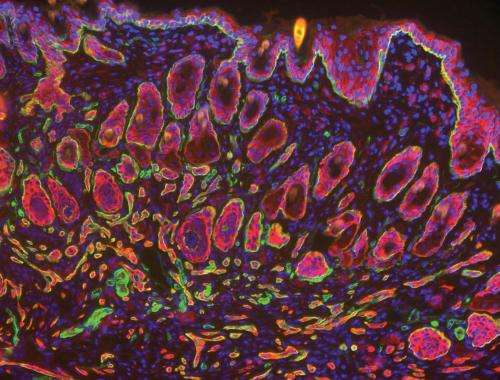January 17, 2014 report
Study using RNAi reveals previously unknown mice genes linked to cancer development

(Medical Xpress)—A combined team of researchers from Howard Hughes Medical Institute and the Icahn School of Medicine has discovered a previously unknown link between absent genes and the growth of tumors. In their paper published in the journal Science, the team describes a study they conducted using RNAi and how it led to the discovery of a previously unknown genetic link to cancerous tumors.
Over the past several years, scientists have learned that genes play a far greater role in cancer development than had been previously thought. One of the things they've discovered is that in addition to genetic markers that show a predisposition to certain types of cancers, there can also be a predisposition to cancer if certain genes are absent or don't work properly, i.e. those that cause the creation of proteins or other chemicals that fight or discourage the formation of tumors. In this new study, the research team was using a relatively new technique to suppress genes—in vivo RNA interference (RNAi), a method that allows for modifying genes in an embryo that doesn't itself cause damage or changes to the embryo—to isolate genes that have been identified with tumor growth (squamous cell carcinomas) in the head and necks of mice.
Prior to the development of in vivo RNAi, researchers would modify genetic components and then graft them onto an embryo. Though effective in some respects it also suffers from causing possible genetic changes due to immune response and also embryonic response to the wound that was created. The new method is non-invasive and allows for much more accurate placement of changed genetic material.
The researchers were using the technique to shut off different genes to learn more about what happens to mice that grow to maturity when they don't have them, i.e. which develop tumors and which don't. In so doing, the team confirmed several genes previously associated with tumor development—the kind that are responsible for causing the production of proteins that fight tumors. Surprisingly, however, they also discovered seven that had never been identified before.
This discovery adds more information about cancer causing agents in mice, of course, which might be applicable to humans, but it also proves the worth of RNAi, and indicates that it might just become a major research tool in the fight against cancer in general.
More information: Direct in Vivo RNAi Screen Unveils Myosin IIa as a Tumor Suppressor of Squamous Cell Carcinomas, Science 17 January 2014: Vol. 343 no. 6168 pp. 309-313 DOI: 10.1126/science.1248627
Abstract
Mining modern genomics for cancer therapies is predicated on weeding out "bystander" alterations (nonconsequential mutations) and identifying "driver" mutations responsible for tumorigenesis and/or metastasis. We used a direct in vivo RNA interference (RNAi) strategy to screen for genes that upon repression predispose mice to squamous cell carcinomas (SCCs). Seven of our top hits—including Myh9, which encodes nonmuscle myosin IIa—have not been linked to tumor development, yet tissue-specific Myh9 RNAi and Myh9 knockout trigger invasive SCC formation on tumor-susceptible backgrounds. In human and mouse keratinocytes, myosin IIa's function is manifested not only in conventional actin-related processes but also in regulating posttranscriptional p53 stabilization. Myosin IIa is diminished in human SCCs with poor survival, which suggests that in vivo RNAi technology might be useful for identifying potent but low-penetrance tumor suppressors.
© 2014 Medical Xpress














